San Diego Zoo has 650 animal species on 100 acres. It’s impossible to see every exhibit in one day. But you can see all of the top San Diego Zoo attractions. Here’s what they are, what makes them special, and the best order in which to visit them all in a day. Don’t just start walking in a random direction as I did on my first visit!

Top 15 Animal Exhibits & Attractions at the San Diego Zoo
- Guided Bus Tour and Skyfari – great overviews of the Zoo
- Wildlife Explorer’s Basecamp – the children’s zoo
- Polar Bear Plunge – diving bears
- Gorilla Tropics – great apes, green, lush exhibit
- Koalas – the kings and queens of cuteness
- South African Penguins swimming with the sharks
- Feed giraffes – an unforgettable experience, cheap
- Lions – on the biggest cat trees you’ve ever seen
- Elephant Care Center – pachyderm pedicures
- Hippos – grace underwater
- Red Pandas & Snow Leopards – cuteness
- California Condors – monster-sized birds
- Swamp Monkeys Playing with Otters – for giggles
- Orangutan Trail – they think you’re fascinating
- Lemurs & Leopards in Africa Rocks – animal drama
Don’t forget that eating well can also be a highlight of your zoo trip. There are many eating options within San Diego Zoo (read about it on my website HERE). Also, check out my article on restaurants within Balboa Park but outside of the Zoo.
If you make purchases through the links in this post, I may be compensated. Read my Advertising Disclosure for more info. Thanks! ~ Nancy
*Save with a secret promo code on each San Diego Zoo or Safari Park 1-Day Pass. Go any day. Go directly to the gate. Click HERE to get your code, instructions & discounted tickets by email. By clicking the link above you agree to receive an automated email message. Valid only at aRes Travel, San Diego’s local authorized ticket seller. Read my full privacy policy.
Top 15 San Diego Zoo Exhibits and Attractions In Best Viewing Order (to save you time and steps)
- Guided Bus Tour and Skyfari
- Wildlife Explorers Basecamp – children’s zoo
- Gorillas in Lost Forest
- Hippos in Lost Forest
- Swamp Monkeys & Otters in Lost Forest
- Red Pandas & Snow Leopards at Asian Passage
- Polar Bear Plunge
- Lions at Elephant Odyssey
- Elephant Care Center
- California Condors at Elephant Odyssey
- Feed Giraffes in the Urban Jungle
- Koalas in Australian Outback
- Vervet Monkeys, Leopards & Lemurs in Africa Rocks
- Penguins in Africa Rocks
- Orangutans at Orangutan Trail
BONUS: Hike Fern Canyon Trail
For 30 more ways to save money visiting the animals, check out my San Diego Zoo discount tickets page. Be even more frugal by reading my article on the best kid-friendly budget lodgings close to the zoo.
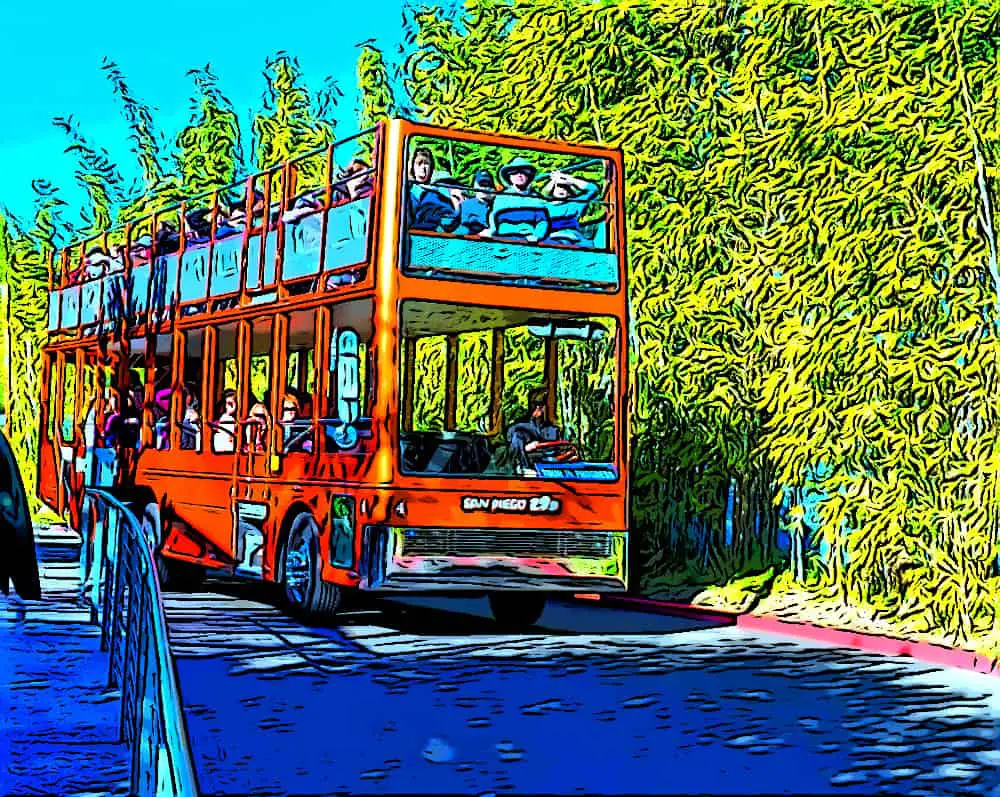
#1 Take a Guided Bus Tour for a San Diego Zoo Preview
The Guided Bus Tour is one of San Diego Zoo’s best attractions for four good reasons:
- It gives you a great overview of the zoo’s layout. And it helps you plan which exhibits you may want to return to later in the day.
- The tour operators will let you know about recent zoo baby births and additions to the collection
- Sometimes the best views of the hippos and tigers are from the tour bus.
- You can see about 70% of the zoo within 35 minutes. And it’s included with your admission.
San Diego Zoo Bus Tour’s Best Side – Where to Sit
Sit on the driver’s right-hand side of the bus on the upper deck. You’ll see more animals and more of the zoo.
On hot, sunny afternoons you may want to ride in the bottom level of the bus. San Diego sun can feel quite intense on the upper deck of the bus because there’s no shade up there.
You might want to skip the Guided Tour Bus if you have a squirmy toddler. If the thought of your little tyke sitting still for more than half an hour makes you laugh hysterically, don’t ride the bus with them. Take your tot on a quick side trip to watch the flamingos while the rest of your group rides around the zoo.

Ride Skyfari Aerial Tram for a Scenic Zoo Shortcut
This aerial gondola ride takes you from the entrance to the Children’s Zoo all the way across the canyon to the entrance to Elephant Odyssey. The overhead views of the Zoo and the tower of the Museum of Man in Balboa Park are justifiably famous. It’s also a great way to cool off on hot summer days.
#2 Wildlife Explorers Basecamp
The new San Diego kids zoo, Wildlife Explorer’s Basecamp is jam-packed with fascinating sights, smells, sounds, and activities. There’s so much to do and see that I created an entire page on this San Diego kid’s zoo. It includes tips on how to get in cheap, when to go, how long it takes, and what not to miss.
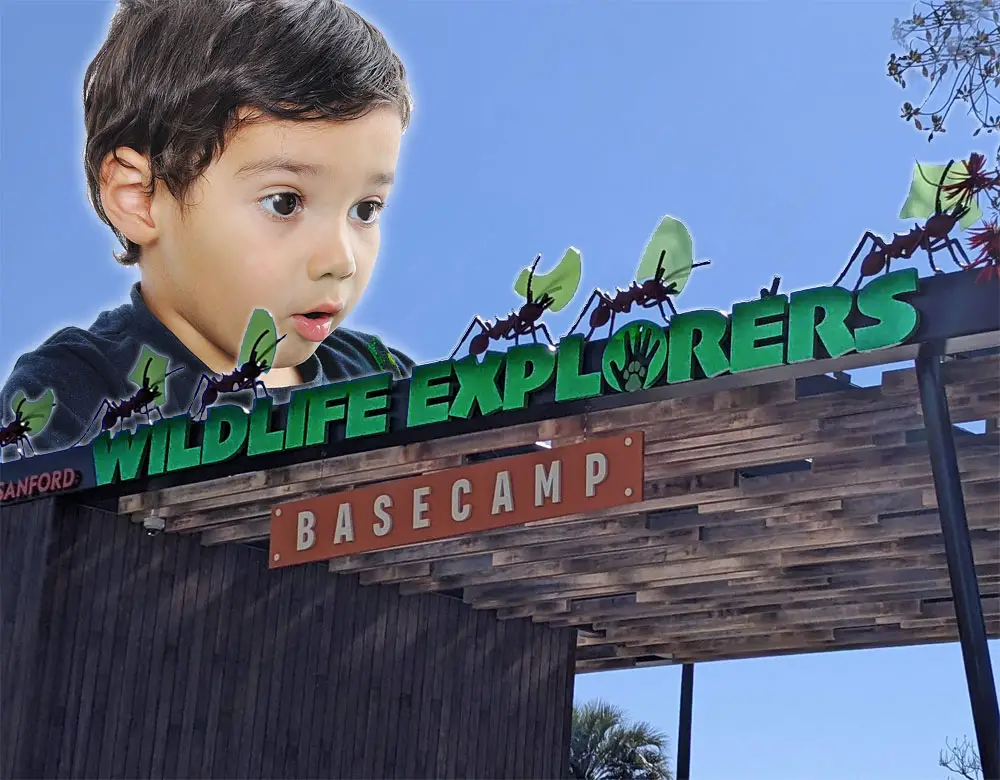
But…if you’ve got kids under 5 years old, visit this attraction last. That’s because parents say that this area’s basically a giant playground that your kiddos won’t want to leave until they’re totally exhausted (and soaked!). You won’t get to see the rest of the zoo.
You don’t have to be a kid to thoroughly enjoy yourself in this 3.2-acre attraction. Adults will exercise their curiosity and sense of wonder. Don’t miss the prairie dog and burrowing owls, fennec foxes, squirrel monkeys, the Tree of Dreams, and the Migration Flyover Experience in the Spineless Marvels building.
#3 Visit the Gorillas in San Diego Zoo’s Lost Forest
Gorillas have been the most popular animals at the San Diego Zoo since the 1930’s. And that’s unlikely to change any time soon. People love interacting with them, especially their babies and youngsters. As for the apes, they can’t understand why you silly primates stay on the hard concrete outside their enclosure when it’s so green and lush inside Gorilla Tropics.
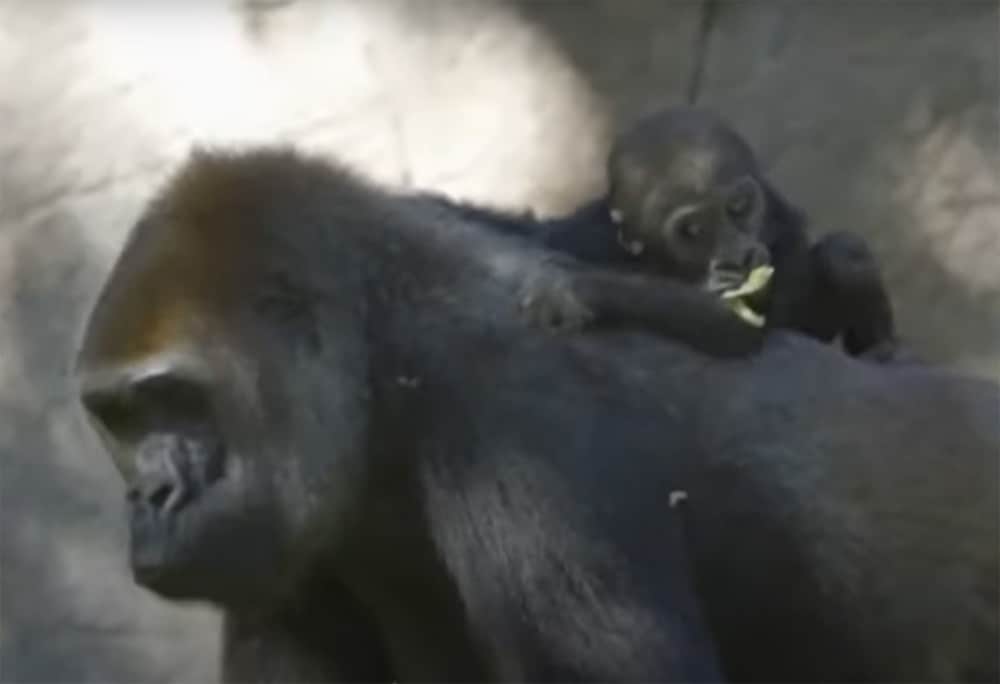
The best time to see the gorillas is before 4 PM. Sometimes the gorillas choose to go into their back room then to get away from their adoring public. There are no set feeding times. But leaves, fruit and other food is put out 6 times a day.
Don’t ever bang on the viewing glass or yell. Don’t let your offspring do it either. It’s just rude. Gorillas are intelligent and express many of the emotions that we do. How would you like it if some stranger started banging on the windows of your home and shouting at you?
INSIDER TIPS:
Take the Monkey Trail to get to the Gorilla exhibit. It’s not as quick as Treetops Way, but there’s so much more to see along this route. The path goes by my favorite monkey, the spectacular black and white Colobus.
#4 See Hippos Running Underwater in Lost Forest
The hippos are one of the top exhibits at the San Diego Zoo because you can have a safe, close-up experience with one of the most dangerous animals on the planet.
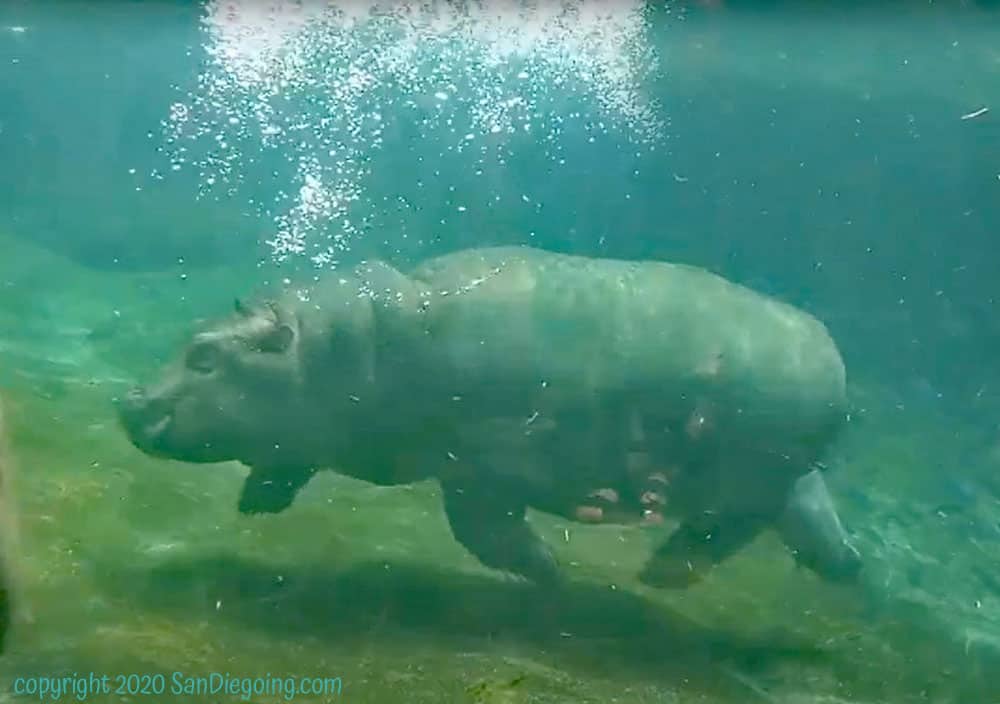
Hippos aren’t fat and clumsy, but they are big (with enormous teeth). They’re the size of a white rhino, but they bound along the bottom of their habitat like big balloons. Before I saw this exhibit I couldn’t imagine where the Disney artists got the idea for the hippo ballerinas in “Fantasia”. Now a hippo with a tutu makes a lot of sense.
Hippos prance along stream beds because they cannot swim. Which is strange, since they’re the closest living relatives to whales. (Want to see whales in San Diego? Go to Cabrillo National Monument Kelp and Whale Overlook). Their bodies are too dense. So they make use of clear eye membrane goggles and nose flaps to keep the water out between bounces to the surface to take quick breaths.
INSIDER’S TIPS:
The hippos like to hang out on the left side of their pool. There’s always a crowd of people there. This is especially true if there’s a baby out on exhibit that day. If you’re taking photos with a cell phone you’ll need a bit of patience to get close to the glass. Be patient, the view’s worth it.
If you’ve got small children they’ll have fun playing on the big bronze hippo sculpture. The statue is surrounded by that squishy playground surfacing to keep them from skinning their knees if they fall down.
#5 Swamp Monkeys and Otters Playing in Lost Forest Will Make You Smile
The Swamp Monkeys and Otters are top animals at San Diego Zoo because you get lots of monkey business when you combine baby guenons with frisky otters.
African spotted necked otters are naturally curious, intelligent, and playful. They’re always investigating, hunting, or playing with something. They like to wrestle and play tag with each other both in the water and on the land.
They’ve learned to play tag with the African spotted necked otters. They touch the otters’ tails and run away and the otters chase them.
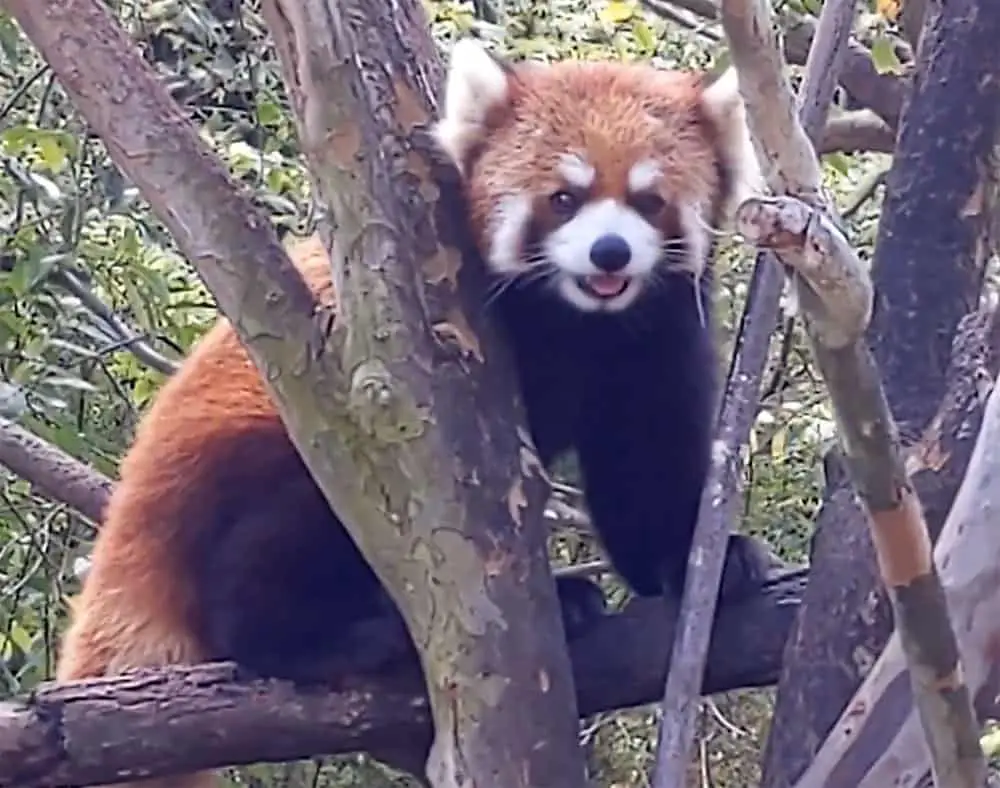
#6 Red Pandas & Snow Leopards at Asian Passage – Cute & Beautiful
The cute red pandas and gorgeous snow leopards in Asian Passage make this San Diego Zoo exhibit a top attraction. This area of the zoo used to get a lot more attention before the giant pandas went back to China in 2019. But it’s still worth visiting because red pandas are the most adorable creatures that you’ve probably never heard of. And the snow leopards are still eye-poppingly gorgeous..
RED PANDAS
About the only things that the red pandas have in common with the giant panda is that they eat bamboo leaves and they’ve got a fake thumb.
These red and white raccoon-like creatures are vegetarian carnivores. That seems contradictory. But it just means that they eat mainly plants in spite of belonging to the Carnivore biological order that includes cats, dogs, and bears.
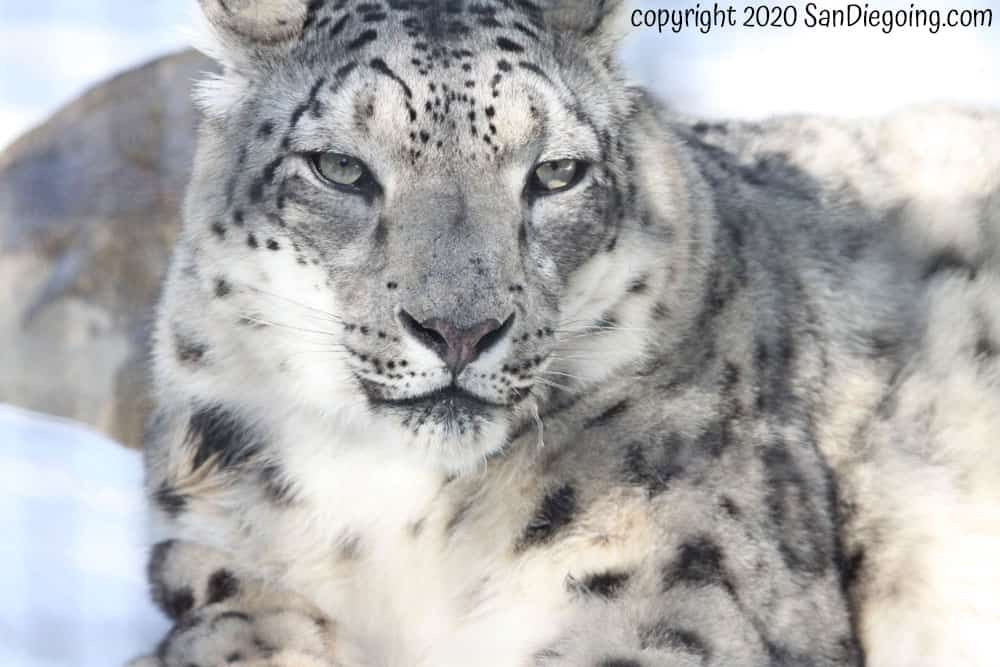
SNOW LEOPARDS
These beautiful cats are called the “ghosts of the mountains” because they’re able to blend into their mountain habitat so easily that they seem to disappear. Add to this the fact that they’re solitary hunters and very rare and you have the stuff of legends.
And if you’re a red panda they’re likely to call you lunch.
INSIDER’S TIP:
The big cats often get fed frozen white rabbits on Sunday mornings. You may want to avoid this exhibit if someone in your group is likely to be upset by this. Other times a large femur is hung where they have to jump up to successfully “kill” it and eat.
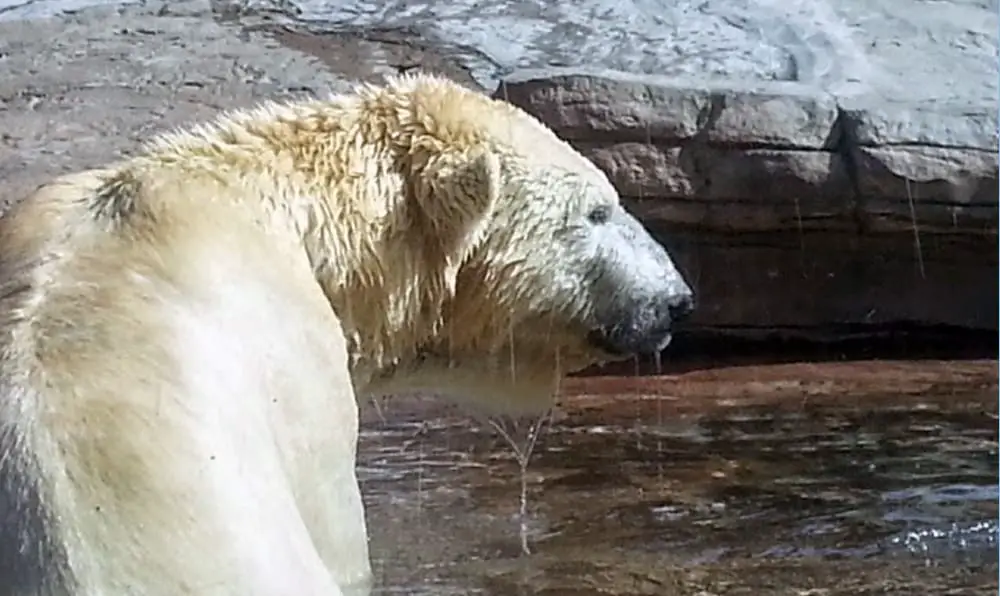
#7 Watch Polar Bears Plunge in Northern Frontier
The polar bears in Northern Frontier are a don’t miss San Diego Zoo exhibit because they’re so much fun to watch. And the observation windows at Polar Bear Plunge make it easy both when they’re on land and in the water.
They’re intelligent and playful. They like to prank each other. Have you ever snuck up on a friend in a pool and then jumped in with a cannonball splash to startle them? That’s what the polar bears do too.
They also love junk food. Only in their case the empty calorie snacks are carrots. They can’t digest them, but the bears love them.
Polar bears are really black. Their fur is not white, but translucent. It only appears white because it reflects visible light back at you.
INSIDER’S TIP #1: The polar bears’ favorite diving rock is in building 27. There’s plenty of seating in the shade inside. It’s a great place to rest and be entertained, especially on hot days.
INSIDER’S TIP #2: One unusual creature that you do not want to miss in this area is the South American Maned wolf. These long-legged rusty-colored canids are not technically wolves, but they fill the same niche in their area as the gray wolf does in North America.
If you LOVE wolves and want to get close-up looks, visit the California Wolf Center in Julian, CA. I’ve written all about it HERE.
#8 Listen to Lions Roar at Elephant Odyssey
The lions have been one of the top animals at San Diego Zoo since its beginning. That was shortly after the 1915-16 Panama-California Exposition in Balboa Park.

In their glassed-in den, you’ll see just how enormous they really are, from their big teeth to their huge claws and paws. Males weigh up to 550 pounds and can reach 10 feet long. That’s HUGE.
You’ll likely find these laziest of cats asleep, (they can sleep 16-20 hours per day), but there’s plenty of other things to see around the lions’ enclosure too.
Check out the jaguars’ enclosure next door. They’re more likely to be awake. And they may be fishing in their stream.
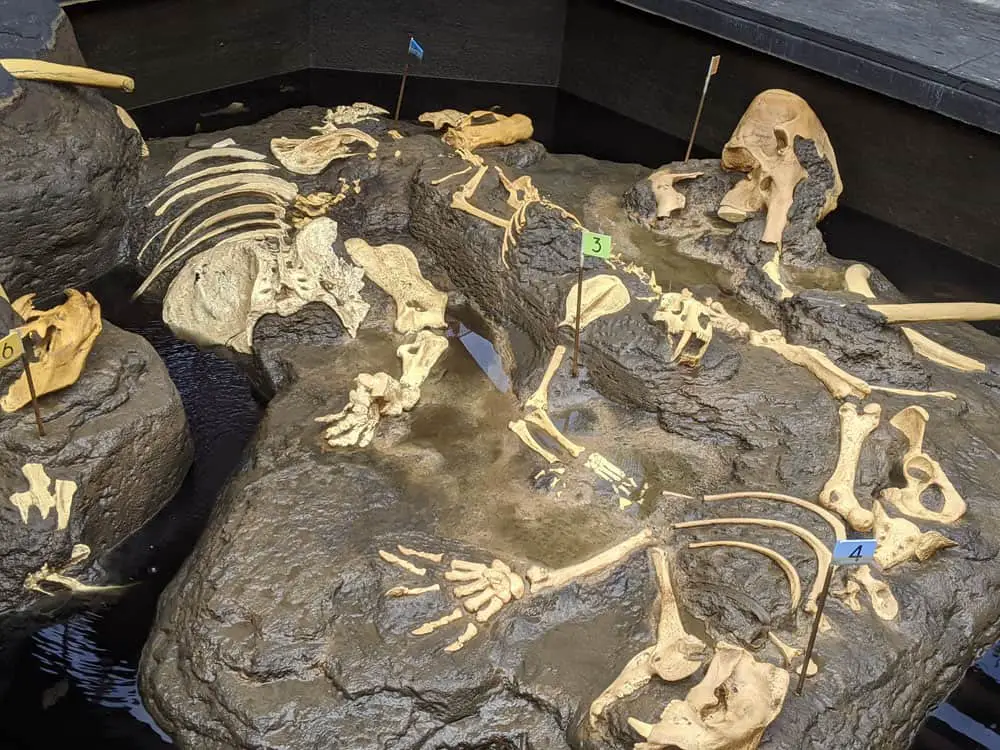
Don’t miss the Fossil Portal’s ‘tar pit’ that empties and reveals ancient lion and mastodon bones.
There’s usually a replica of a saber-tooth tiger skull that you can touch. Run your fingers behind the large front teeth and feel the serrated edges that helped them puncture the thick hides of their prey.
INSIDER TIPS:
Remain alert. If you see the male lion turn his back on you and raise his tail, walk quickly away…immediately. At least turn away or shield your face. Male lions can spray up to 10 feet and it really stinks. He’s not being mean, he’s just feeling a bit crowded and wants all the people to know who’s really the boss of this territory.
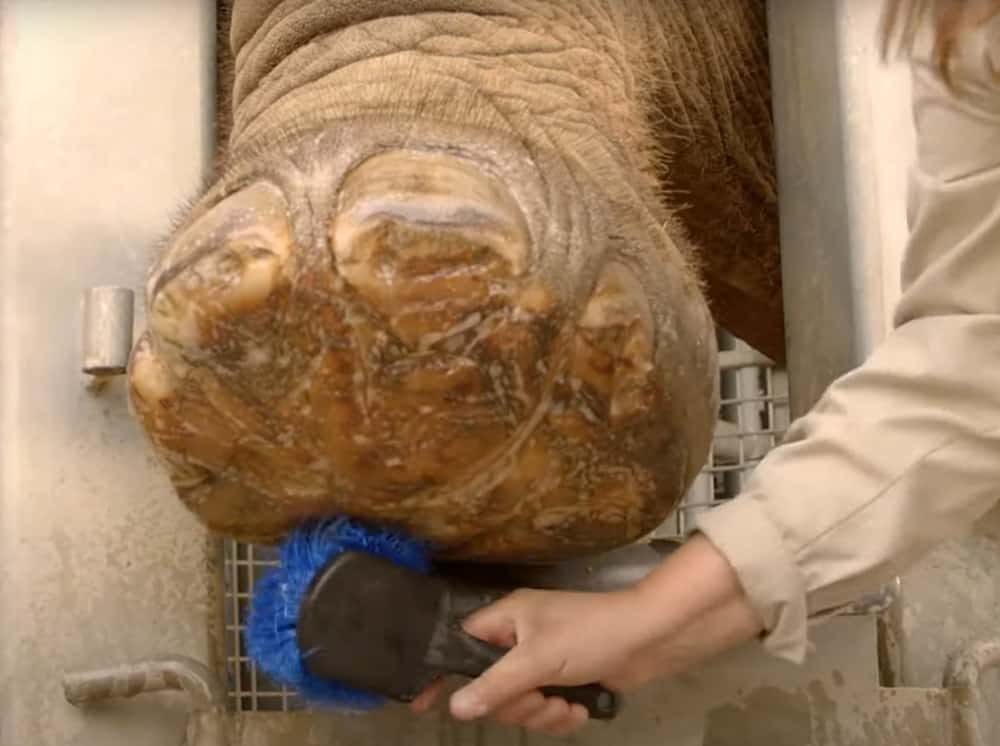
#9 See Pachyderms Get Pedicures at Elephant Care Center
The Elephant Care Center is a San Diego Zoo must-see because it’s so unusual. Seriously, you’re not the least bit curious about a spa for elephants? You’ll see these gentle giants getting their nails and foot calluses filed by a wood rasp. They get garden hose showers and back scratches from brooms.
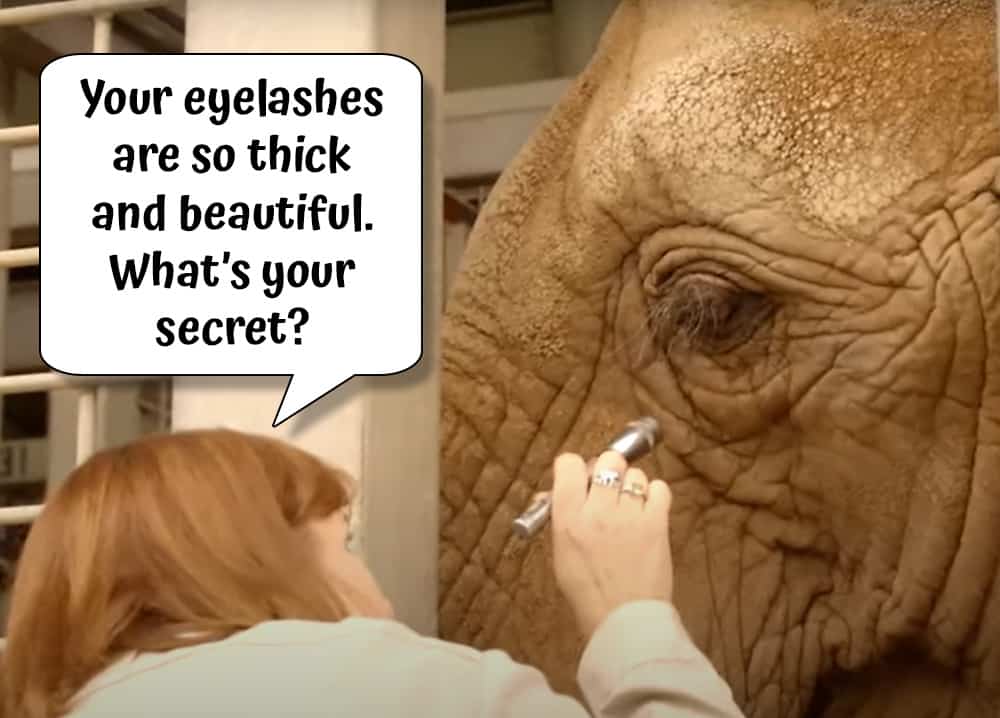
This facility houses geriatric elephants from Safari Park and other zoos from throughout the US. It’s heartwarming to see the hard work of the keepers as they care for these elders. And the elephants appear to enjoy all the primping and fussing that they get in their ‘spa’.
There are also plenty of opportunities to view elephants in more conventional settings. They’ve got room to roam, ‘browse’ from feeding stations, and even take a bath in a pond.
INSIDER TIPS:
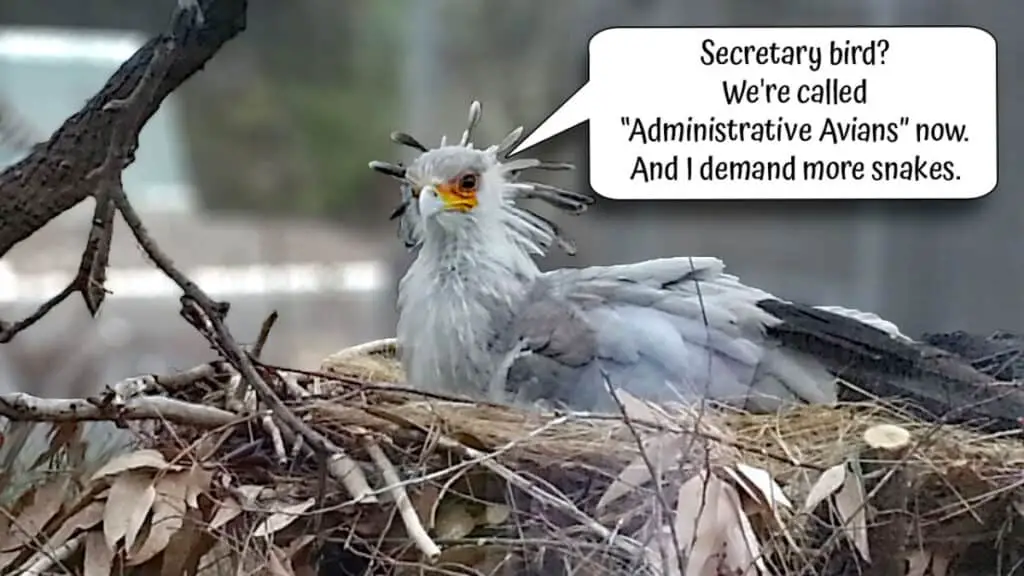
Don’t miss the spectacular secretary birds. They’re on the other side of the path across from the Elephant Care Center. These stork-like birds have a gorgeous red and yellow-skinned head with a fanciful crest of grey feathers and an impressive beak. They’re also sometimes tamed because they eat venomous snakes. It’s hard not to take a great photograph of them.
#10 Catch California Condors Scavenging In Elephant Odyssey
The California Condors are a San Diego Zoo top attraction because they’re monster truck-sized birds and one of the biggest conservation success stories anywhere.
In 1982 there were only 22 of these magnificent birds left in the wild. The San Diego Zoo was given permission by the US Fish and Wildlife Service to start a zoological propagation program to save the species. By 1987 they were extinct in the wild. In 1988 the first zoo-bred California condor was born. More followed and the first ones were reintroduced to the wild. Now the world population of California condors is more than 500 and rising by about 50 per year. More than 330 are soaring free in the wild.
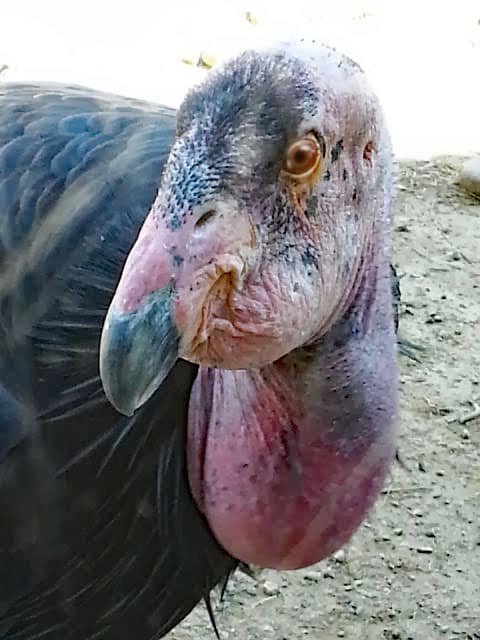
One more wild thing about these avians, condors can reproduce without mating. In 2021, two of their male condor chicks were genetically tested and found to have male sex chromosomes, but all other markers were only inherited from their mothers. This is very rare in birds, although it’s been seen in turkeys and domestic pigeons.
Everything about California condors is mega jumbo. Their bodies reach 4 to 5 feet long. Their wingspan can stretch 10 feet from wingtip to wingtip. They soar up to a cloud-piercing 15,000 feet, almost 3 miles up. They’ve been clocked flying at 56 mph and sometimes fly 160 miles in a day in search of carrion. They live 60 years in the wild.
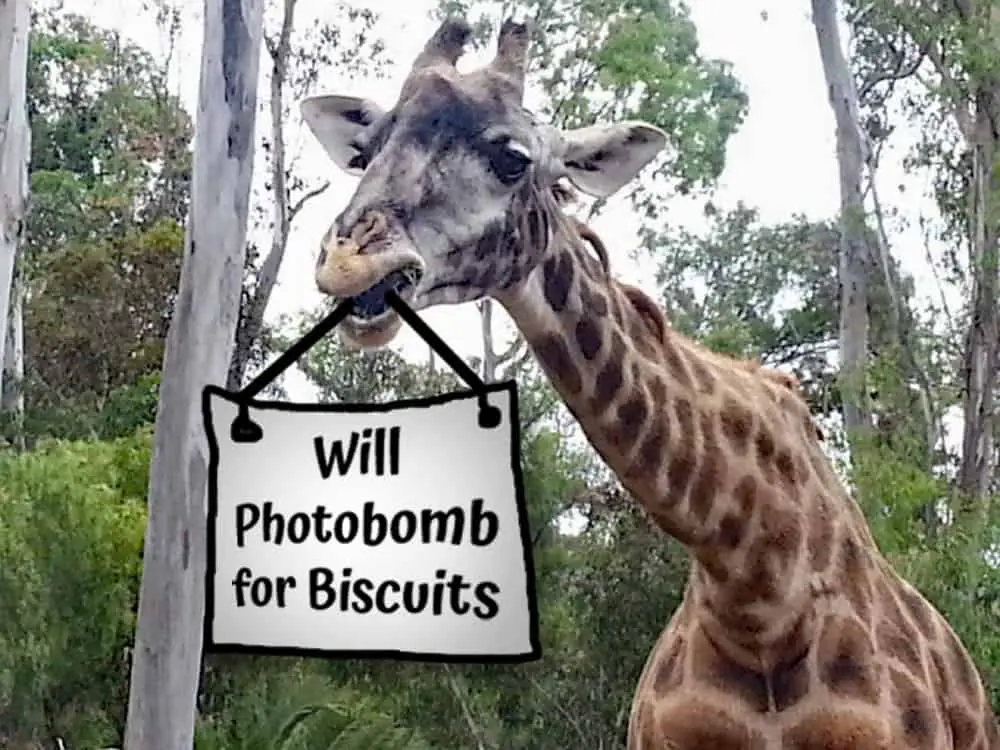
#11 Feed Giraffes and Rhinos in the Urban Jungle
The giraffes and rhinos in Urban Jungle are some of the top animals at San Diego Zoo because they’re startlingly HUGE. Even if you’ve seen these animals before, this area is unique because they are standing at the same level as you.
We humans have a hard time grasping just how big they are in comparison to us. Feeding them brings their enormous heads where we can look them in the eye and say, “WOW”.
If you cannot get to the Zoo in time for the giraffe and rhino feedings, go to the Urban Jungle to see these beautiful behemoths anyway.
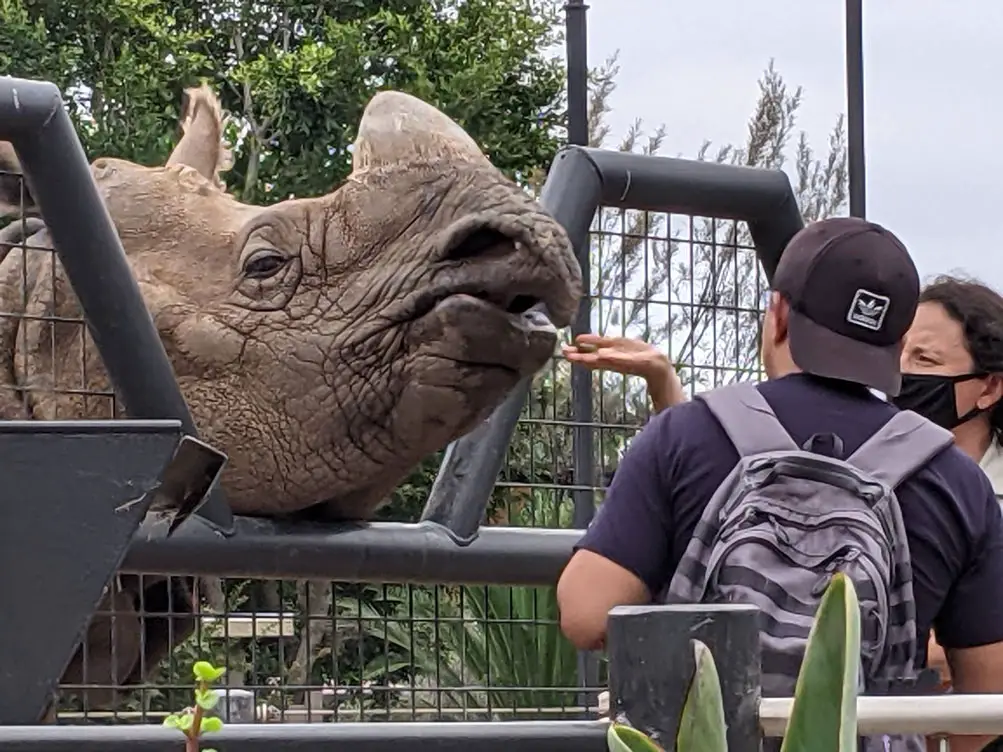
INSIDER TIPS:
You must purchase a $15 Animal Experience ticket for these events before the event. Tickets are sold from the Urban Jungle Adventures Ticket booth, which is a small shed located behind Sydney’s Grill.
- Giraffe Experience tickets available 1 hour before event
- Rhino Experience tickets available 30 minutes before event
These experiences aren’t listed on the Zoo website because they are dependent upon the health of the animals and available zoo personnel.
Note: The Rhino Experience is temporarily unavailable while the hippo habitat is being remodeled. The rhino is reportedly romancing a cutie at Safari Park.
| Feeding Experience | Days | Feeding Times |
|---|---|---|
| GIRAFFE – 3 biscuits. 8 people maximum | Th – Sun | Noon – 1:00 PM 5:00 PM – 6:00 PM |
| RHINO – (temporarily unavailable) 3 biscuits. 4 people maximum |
You’ll be guided by a zoo wildlife care specialist, so you don’t have to worry about possibly upsetting a multi-ton animal. You’ll have 3 opportunities to feed the animal in every ‘experience’ you purchase.
#12 Capture Koala Cuteness in Australian Outback
The koalas in Australian Outback are one of San Diego Zoo’s top attractions because this is the largest breeding colony of koalas outside of Australia. The viewing experience is actually better than seeing them in the wild in Australia because they’re in trees at your eye level. You don’t have to put a cramp in your neck or suffer eyestrain from trying to spot them in 100-foot tall eucalyptus trees.
It’s also a must-see because koalas have faces that look like they’ve just eaten chocolate dunked in bliss. They’re a dopamine flood in your reward center that you need, nay, deserve!

People always ask, can you pet the koalas? The short answer is that you cannot. For all their cute looks, they’re very unpredictable. They could hurt you or themselves. If you are interested in closer animal encounters see my page on holding animals at the San Diego Zoo.
INSIDER TIPS:
Keepers put out new eucalyptus leaves in the mornings. The koalas will be a bit more active then. They may even have their adorable button eyes open!
Do you want photos of your kids with koalas? There’s a climbing sculpture with bronze koalas on it that’s perfect. And if your child happens to fall down, the ground is covered with that spongy playground material.
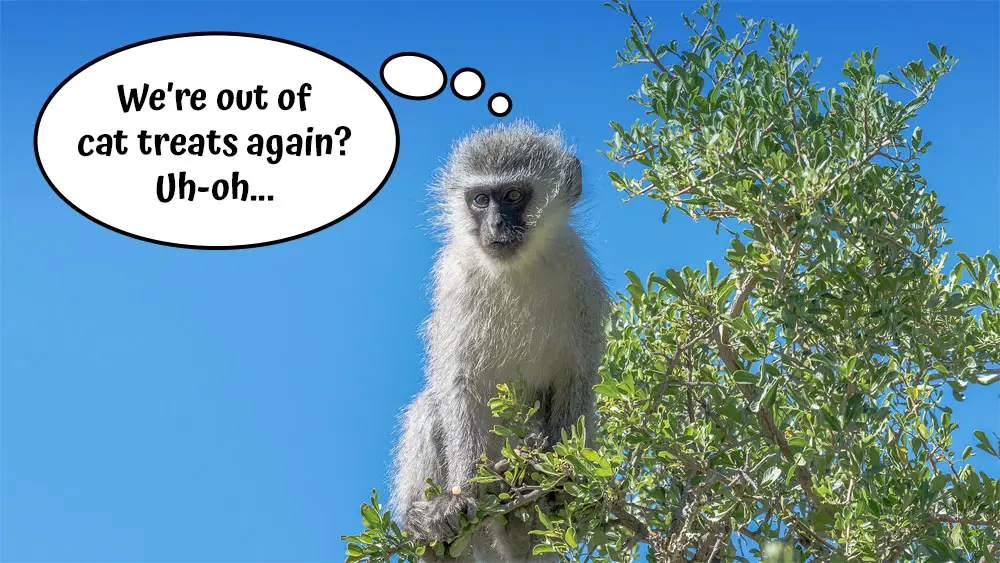
#13 Watch the Vervet Monkeys Tease Leopards at Africa Rocks – Plus Lemurs
This is a San Diego Zoo must-see exhibit because Vervet monkeys are treetop ninja masters with a mischievous streak a mile wide. And the zoo has deliberately placed them close to leopards, their natural predators. The interaction between the two species keeps both interested in their environment.
Even though none of these monkeys have ever been hunted by leopards, they instinctively recognize that the Amur leopards next door are dangerous. They also know that those big spotted animals can’t reach them. So they get close to their common fences to keep a careful watch. That gets the cats all excited and you’ll see crouched leopard tails twitch with anticipation of them coming within reach of a pounce.
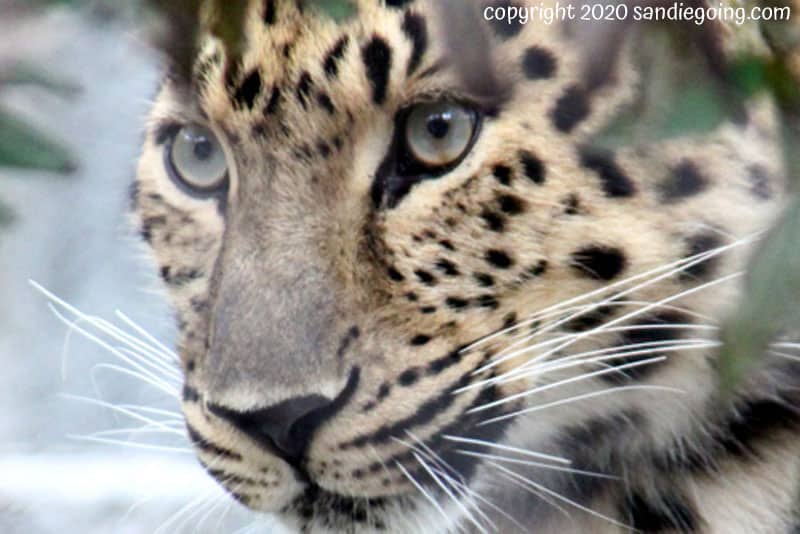
Then the vervets lose their nerve and they bound away through the trees with incredible acrobatic ease making an alert call that’s specific to leopards. The cat then usually sits up like it was never really interested in a monkey lunch and starts grooming itself. That’s typical cat behavior. But as soon as the little aerialists come back it gets excited again.
These exhibits are also close to the lemur enclosure. It has 5 different types of these Madagascar primates. And they too are situated close to their predators, the fossa.
INSIDER TIP:
Are you a little squeamish? The leopards are often fed on Sunday mornings. Seeing the cats tear apart frozen bunnies can be a bit upsetting for some kids and adults. If that’s the case, hurry on downhill towards the distraction of happily playing lemurs.
Also, the leopards in Africa Rocks are Asian Amur leopards, not the African ones. That’s because the San Diego Zoo is part of the Amur leopard species survival plan and the space is needed for a breeding group of these big cats.
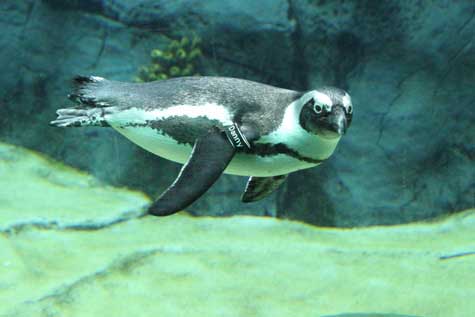
#14 See Penguins Flying Underwater at Africa Rocks
The African penguins & leopard shark aquarium at San Diego Zoo is one of the largest of its kind. It’s 170 feet long — that’s longer than the Arc de Triomphe in Paris is tall. The aquarium is 13 feet deep in spots. The 200,000-gallon saltwater pool has a wave-making machine to mimic gentle surf rolling ashore on a cobblestone beach.
Their underwater observation area has 12-foot tall windows and benches where you can watch the penguins zig-zag and dart in their pool. They steer with their feet and “fly” through the water with their short, flat, stiff wings.
Penguins like being hand-fed sardines, caplin, and night smelt. They swallow them whole, head first. And when they’re waiting for food you can hear them make a noise like a braying donkey. That’s the reason why they’re also known as “jackass” penguins.
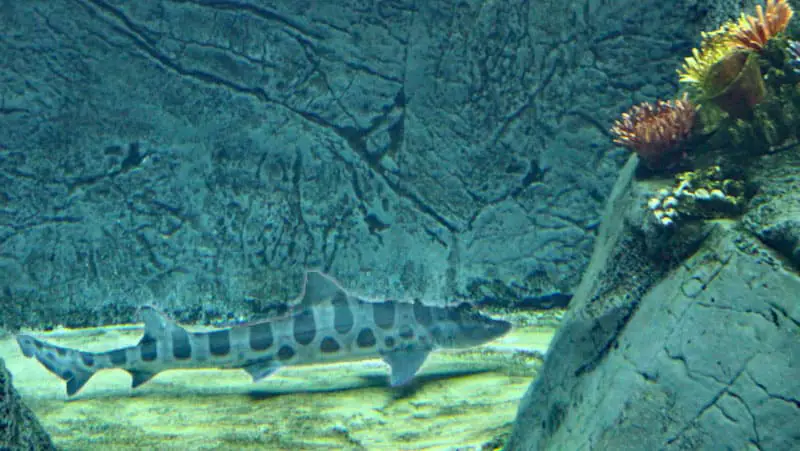
Another unusual feature of this exhibit is the leopard sharks. No one else has ever housed these sharks with South African penguins. The aquatic birds live with gully sharks in their native waters. Leopard sharks found off the coast of San Diego fill the same niche as the gully sharks. So the decision was made to showcase a local species instead of shipping the gully sharks thousands of miles.
Even though the female sharks can grow to be 7 feet long (males are smaller), they are no threat to the penguins. Leopard sharks are bottom feeders and eat clams, crabs, squid, fish eggs, and small fish.
INSIDER TIPS:
This is a wonderful place to relax and cool off on hot days. The underwater viewing area is in the shade and there are plenty of benches to sit on.
Sometimes, if the penguins are hungry, or especially curious, they’ll watch and follow you or your kids. It’s good to know that they’re well cared for enough to be as curious about you as you are about them.

#15 Watch Orangutans Watching You at Orangutan Trail
The orangutan exhibit is a San Diego Zoo don’t miss experience because of their intense intelligence and curiosity about us. And we’re fascinated by their long arms and prehensile feet that make climbing trees look like arboreal ballet. Their habitat is also beautiful with lush greenery, ponds and flowing water.
Orangutans are known as the “old men of the forest”. They’re introspective, unlike chimps or gorillas (and some humans). When they have a problem to solve they don’t monkey around wasting a lot of energy trying one thing after another. They carefully observe. Then at the right time, they take one very specific action, applying just enough effort to get what they want. They’re like Yoda with orange fur.
The most famous San Diego Zoo orangutan was Ken Allen. This male Bornean orangutan became a San Diego folk hero. He had his own fan club, t-shirts & bumper stickers. He was dubbed “Hairy Houdini” after several escapes from his enclosure in the 1980s. But he wasn’t really serious about escaping the zoo. He’d be waiting just outside his exhibit when the keepers came in the next morning.

INSIDER TIPS: Ken Allen has a memorial plaque at the San Diego Zoo. It’s located on the opposite side of the path from the orangutans’ enclosure.
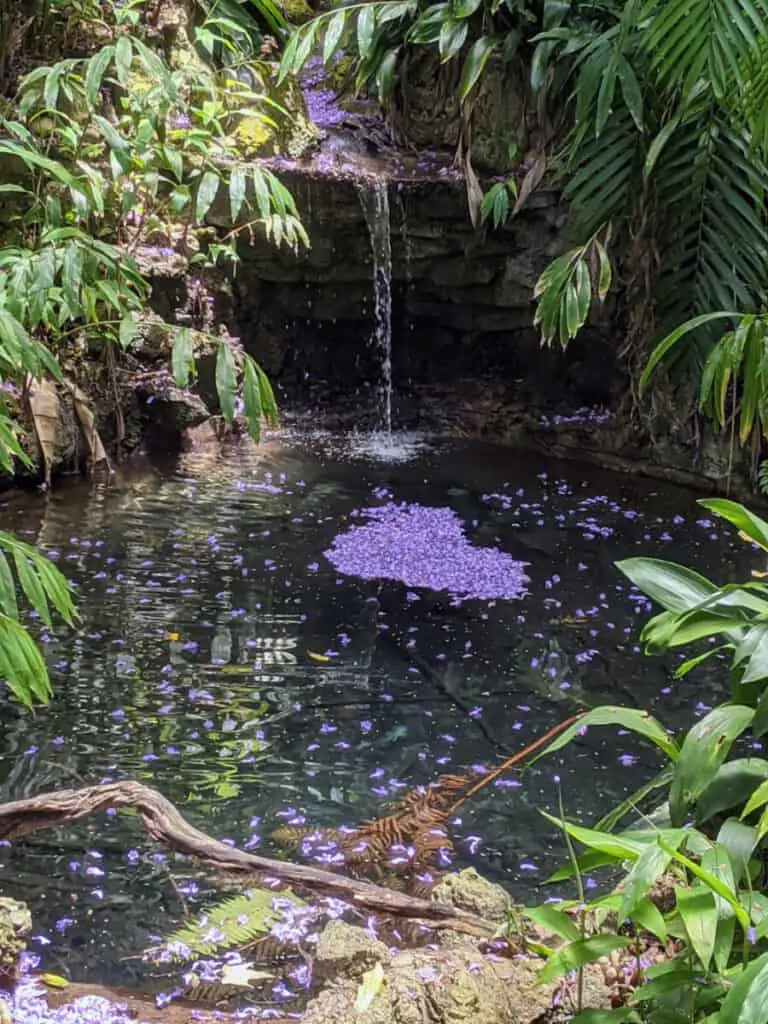
BONUS: Hike Fern Canyon Trail, the Most Scenic Part of the Zoo
Walking down Fern Canyon is a San Diego Zoo must-do because it’s the most beautiful, secluded part of it. The path is lushly planted and periodically crosses a meandering downhill stream and several waterfalls. But you have to be in good physical condition to appreciate it.
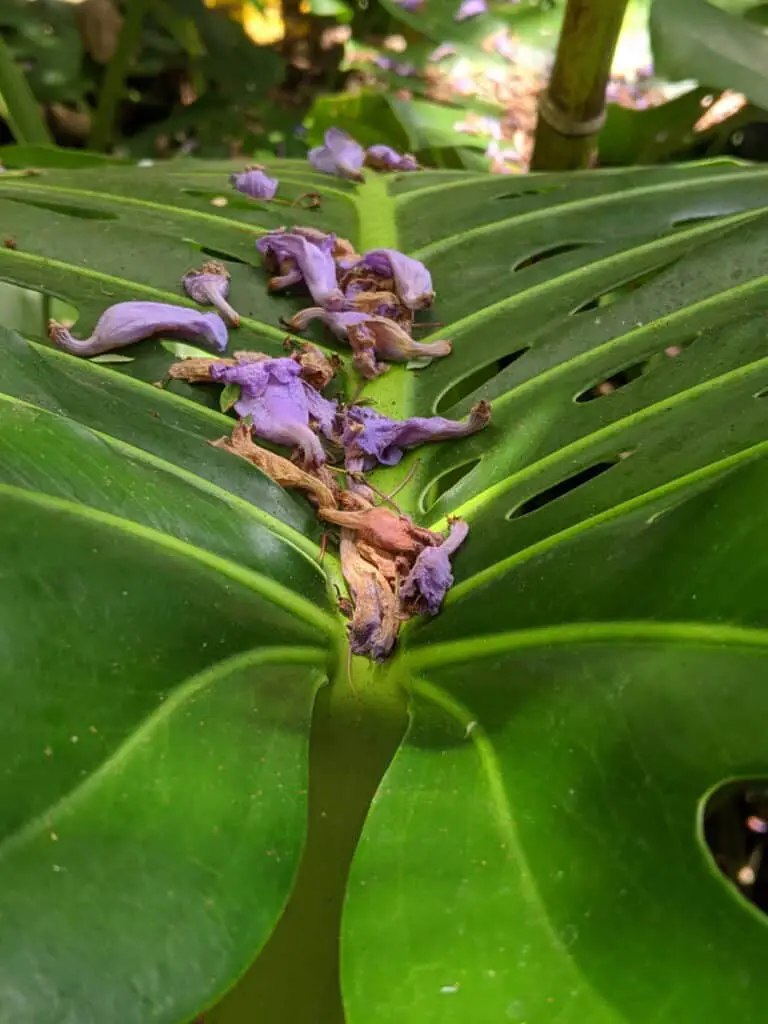
It’s just past where the Orangutan Trail meets Treetop Way, but before the bus ticket booth.
INSIDER TIPS:
Don’t try to walk up or down Fern Canyon Trail if you’ve got bad knees. It has many steps. Another way of looking at it is that it’s a great workout for your core muscles, glutes, hamstrings, quadriceps, and calves.
Fern Canyon Trail is also not suitable for strollers. The easier alternate route to the exit is to take the elevator to the top at Bashor Bridge.
Closing Thoughts
I hope that you find this list of the best San Diego Zoo animal exhibits to be helpful when you’re planning your visit. I’ve done my best to let you know not only which ones are not to be missed, but what makes them special.
If you liked this article, you may also be curious about what you should see and do at San Diego Safari Park. It’s the lesser-known animal preserve 35 miles north in Escondido, California. But it’s well worth the trip.
Let me know HERE how I can make this article on the top must-see San Diego Zoo attractions even more useful to you.
